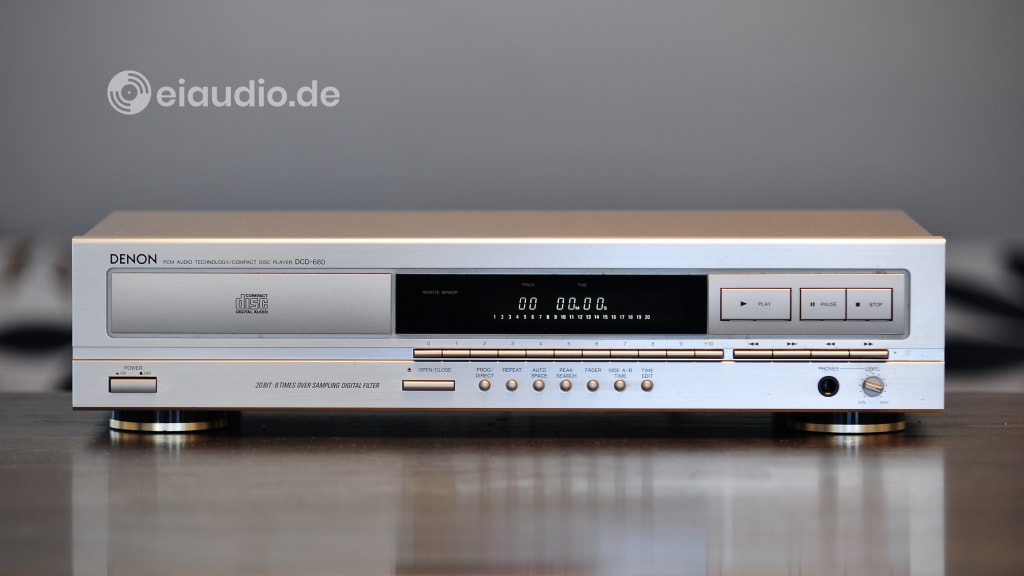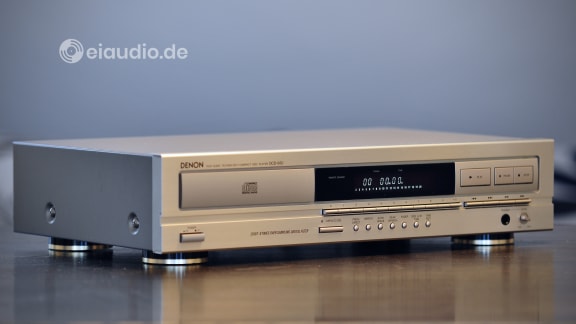Denon DCD-660
Published: 28/01/2023
Manufacturing date: 1991
Author: Karsten Hein
Category: Gear & Review
Tag(s): CD-Players
Let’s face it: There have been some outstanding CD player designs since the dawn of the medium through a joint venture of Sony and Philips in 1982. The Meridian MCD of 1985, for example, that took the housing for a Philips CD 100 and gave it a complete hauling over in terms of the output stage and error correction, similar to the German Roman Gross modifications that came much later. Cambridge followed in the subsequent year with their CD1 that already boasted a separate stack-on-top DAC unit. Arcam, Naim, and Quad all came out with excellent machines that got the HiFi press interested. So did Cyrus and Chord in more recent times, and this list only includes some of the British makers of CD players. However, these renditions all cost a fortune and remained out of reach for all but the most hardcore enthusiasts.
The real bread-and-butter business of the industry were low-priced machines such as the Denon DCD-660 that is the subject of this report. While the Cambridge CD 1 may have changed what was possible with the medium, the Denon DCD-660 affected what was accessible to the households of the average consumers. The Denon answered the question of how many (and what quality of) parts it took to satisfy the prevailing needs of shoppers at this price level. And, as this particular DCD-660 had been handed down to my daughter from her recently deceased great aunt, I wanted to take the opportunity for a quick exploration of its capabilities before installing it in her room. One of the other devices that my daughter had received was a Dual CV 1260 Class-A amplifier, which I enjoyed listening to quite a lot and dreaded having to surrender.
The CV 1260 was connected to our Epicure 3.0 loudspeakers via a pair of unterminated Belden 9497 speaker cables in single wiring. I used our larger and more elaborate Denon DCD 1420 as benchmark and took Diana Krall’s Album All for You as music material for my listening explorations. This album sounded really satisfying on the DCD 1420, and I could not have said that I was missing anything in the music. This in itself was a surprising realisation given the relatively small Dual amplifier driving the large Epicure tower speakers. On the other hand, 44 watts idle power on the side of the Dual suggested that it possessed a sufficient amount of Class-A amplification, as its name suggested.
Opening the DCD-660’s sliding tray for the first time, I noticed that it had some difficulties overcoming the first 1-2 centimetres of its journey. I helped the process by tugging it out gently with my fingers. I repeated the procedure a few times and noticed that it worked better with each application. When CD players remained unused for a long time, the rubber belts that were driving loading mechanism could at times permanently assume the oval shape they were last left in. If the tray had not recovered from my moving it by hand, I would have probably had to change the belt, which could turn out to be a little tricky, depending on the model. On the positive side, I found that the DCD-1420's remote control also worked on the DCD-660.
Right after start-up, the small Denon still sounded a bit harsh and grainy; however, this effect subsided as the machine reached operating temperature. Perhaps this was another indication of the unit having been sitting around unused over a long period of time. I noticed that the tonality was the same between the two Denon players. I would have liked to turn the LCD display off via the remote control to achieve that extra-clean sound, but I found that this function was missing on the DCD-660. The resulting soundstage, therefore, was not quite as clean cut and three dimensional, although I did have the feeling that the larger player sounded even hazier with the display turned on and consequently also benefitted from the display-off feature more. In direct comparison, ultra-low bass seemed a bit more profound on the DCD 1420, but not to the point where I would have minded much.
System integration was not great on the DCD-660, though. It was missing the separate variable Cinch/RCA output sockets of its larger sibling, did not have a digital S/PDIF output to connect an external DAC, and was also missing an optical output for integration in systems with grounding issues. As these criteria had become more and more important to me over the years, I would not have chosen the DCD-660 for myself. However, listeners who exclusively used the direct analog cinch/RCA output anyways, did get a capable CD player with natural tonality and a decent soundstage for a budget price. And, since switching the LCD display off in order to achieve an enhanced soundstage experience is only common in audiophile circles anyway, most owners of the Denon DCD-660 would have had every reason to be happy with and proud of their new device.
Specifications
- Digital converter: PCM61P
- CD Mechanism: KSS-210A (linear tracking)
- Frequency response: 2 Hz - 20,000 Hz
- Dynamic range: 95 dB
- Signal to noise ratio: 103 dB
- Channel separation: 99 dB
- Total harmonic distortion: 0.004%
- Filters: 20 bit / 8-times oversampling
- Line output: 2V (cinch/RCA)
- Variable line output: none
- Digital S/PDIF output: none
- Optical output: none
- Features: 1/3-headphones jack, volume poti
- Accessories: RC-226 remote control
- Dimensions: 434 x 105 x 280mm
- Weight: 3.8 kg
- Country of manufacture: Japan
- Year: 1991





